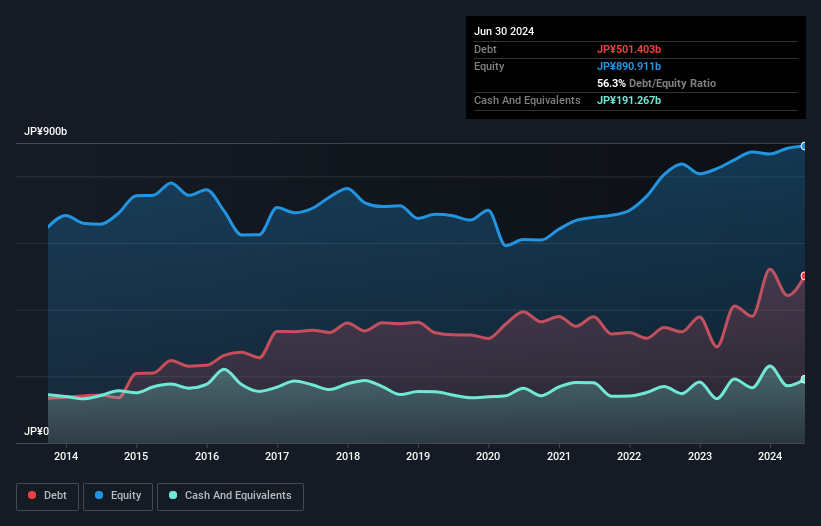
Some say volatility, rather than debt, is the best way to think about risk as an investor, but Warren Buffett famously said that 'Volatility is far from synonymous with risk.' It's only natural to consider a company's balance sheet when you examine how risky it is, since debt is often involved when a business collapses. We note that Ajinomoto Co., Inc. (TSE:2802) does have debt on its balance sheet. But the more important question is: how much risk is that debt creating?
What Risk Does Debt Bring?
Generally speaking, debt only becomes a real problem when a company can't easily pay it off, either by raising capital or with its own cash flow. If things get really bad, the lenders can take control of the business. However, a more usual (but still expensive) situation is where a company must dilute shareholders at a cheap share price simply to get debt under control. By replacing dilution, though, debt can be an extremely good tool for businesses that need capital to invest in growth at high rates of return. When we examine debt levels, we first consider both cash and debt levels, together.
See our latest analysis for Ajinomoto
How Much Debt Does Ajinomoto Carry?
You can click the graphic below for the historical numbers, but it shows that as of June 2024 Ajinomoto had JP¥501.4b of debt, an increase on JP¥410.9b, over one year. On the flip side, it has JP¥191.3b in cash leading to net debt of about JP¥310.1b.

How Strong Is Ajinomoto's Balance Sheet?
We can see from the most recent balance sheet that Ajinomoto had liabilities of JP¥463.8b falling due within a year, and liabilities of JP¥480.9b due beyond that. On the other hand, it had cash of JP¥191.3b and JP¥202.7b worth of receivables due within a year. So it has liabilities totalling JP¥550.7b more than its cash and near-term receivables, combined.
While this might seem like a lot, it is not so bad since Ajinomoto has a huge market capitalization of JP¥2.75t, and so it could probably strengthen its balance sheet by raising capital if it needed to. But it's clear that we should definitely closely examine whether it can manage its debt without dilution.
In order to size up a company's debt relative to its earnings, we calculate its net debt divided by its earnings before interest, tax, depreciation, and amortization (EBITDA) and its earnings before interest and tax (EBIT) divided by its interest expense (its interest cover). This way, we consider both the absolute quantum of the debt, as well as the interest rates paid on it.
Ajinomoto's net debt is only 1.4 times its EBITDA. And its EBIT easily covers its interest expense, being 31.7 times the size. So we're pretty relaxed about its super-conservative use of debt. And we also note warmly that Ajinomoto grew its EBIT by 12% last year, making its debt load easier to handle. There's no doubt that we learn most about debt from the balance sheet. But ultimately the future profitability of the business will decide if Ajinomoto can strengthen its balance sheet over time. So if you're focused on the future you can check out this free report showing analyst profit forecasts.
But our final consideration is also important, because a company cannot pay debt with paper profits; it needs cold hard cash. So it's worth checking how much of that EBIT is backed by free cash flow. During the last three years, Ajinomoto produced sturdy free cash flow equating to 56% of its EBIT, about what we'd expect. This cold hard cash means it can reduce its debt when it wants to.
Our View
The good news is that Ajinomoto's demonstrated ability to cover its interest expense with its EBIT delights us like a fluffy puppy does a toddler. And its EBIT growth rate is good too. Taking all this data into account, it seems to us that Ajinomoto takes a pretty sensible approach to debt. That means they are taking on a bit more risk, in the hope of boosting shareholder returns. Above most other metrics, we think its important to track how fast earnings per share is growing, if at all. If you've also come to that realization, you're in luck, because today you can view this interactive graph of Ajinomoto's earnings per share history for free.
If, after all that, you're more interested in a fast growing company with a rock-solid balance sheet, then check out our list of net cash growth stocks without delay.
New: Manage All Your Stock Portfolios in One Place
We've created the ultimate portfolio companion for stock investors, and it's free.
• Connect an unlimited number of Portfolios and see your total in one currency
• Be alerted to new Warning Signs or Risks via email or mobile
• Track the Fair Value of your stocks
Have feedback on this article? Concerned about the content? Get in touch with us directly. Alternatively, email editorial-team (at) simplywallst.com.
This article by Simply Wall St is general in nature. We provide commentary based on historical data and analyst forecasts only using an unbiased methodology and our articles are not intended to be financial advice. It does not constitute a recommendation to buy or sell any stock, and does not take account of your objectives, or your financial situation. We aim to bring you long-term focused analysis driven by fundamental data. Note that our analysis may not factor in the latest price-sensitive company announcements or qualitative material. Simply Wall St has no position in any stocks mentioned.
About TSE:2802
Ajinomoto
Engages in the seasonings and foods, frozen foods, and healthcare and other businesses in Japan and internationally.
Excellent balance sheet average dividend payer.
Similar Companies
Market Insights
Community Narratives



